This site contains affiliate links. As an Amazon Associate, I earn a commission from qualifying purchases at no extra cost to you. Full Disclosure Here.
For the past six weeks, I have been exploring alternatives to over-the-counter ointments, salves, and beauty products. Not only are these products expensive, but as I have learned time and time again, they don’t always work.
Starting with a basic formula for healing salve that I found on the internet, I decided to make my own all-purpose salve and to test it on various ailments to see how it worked. I added a bit of this, subtracted a bit of that and came up with I call my own Miracle Healing Salve. The funny thing is that when the final results came in, the formula that worked the best as an all-purpose salve was a version included the same blend essential oils I have been using for muscle aches these past ten plus years. Go figure.
Also Read: Preppers Guide

As easy as this Miracle Healing Salve is to make – and it is easy – it just works. I will share some of the uses that I have become ecstatic about but first, the recipe.
Miracle Healing Salve – The Recipe
Ingredients:
1 Cup Coconut Oil (not fractionated)
1 Cup Extra Virgin Olive Oil
5 Tbl. Organic Beeswax Pastilles
Containers:
8 each – 2 ounce jars or containers **OR**
4 each – 4 ounce mason jars
To each 2 ounce jar add: (double if you are using 4 ounce Mason jars)
5 drops Lavender essential oil
5 drops Rosemary essential oil
5 drops Peppermint essential oil
a few drops of Vitamin E (optional)
1. Put a pot of water on the stove to simmer. While the water is heating, put the coconut oil, olive oil and beeswax pastilles in a heatproof jar or measuring cup.

2. Set the jar filled with the coconut oil, olive oil, and wax into the water and leave it there until it melts, giving it a stir from time to time. You want a slow, gentle melt so take your time. It could take 15 or 20 minutes depending on the temperature of the water bath.

3. While the ingredients are melting, drop your essential oils into each of the containers. Hint: I have found that it is easier to use a glass medicine dropper than the dropper that comes with the bottle of essential oil. This is optional and a matter of personal preference.

4. Pour the melted oils into each of the smaller jars containing essential oils. There is no need to stir unless you want to since the oils will mix up on their own.

5. Cover the jars with a paper towel or cloth and set them aside for up to 24 hours. Although the salve will start to firm up within minutes, it takes at least 12 hours to complete the firming process. (The purpose of the cover is to keep out dust, bugs and other nasties that may be floating around.)

A Word About the Ingredients
Coconut oil is a natural moisturizer and is antibacterial. Olive oil is chock full of antioxidants and has anti-inflammatory properties.
Lavender is a natural antibiotic, antiviral, antifungal and antiseptic. It is a master healer that also helps to prevent scarring. Rosemary is also antiseptic and an excellent treatment for muscle aches. Peppermint is an anti-inflammatory and is also antiseptic. Are you seeing a pattern here?
The optional Vitamin E is an antioxidant and is also used as a natural preservative.
10 Ways (So Far) to Use Miracle Healing Salve
These are the ways I have used this salve with success. I am sure there are others that are yet to be discovered but these make a darn good start!
1. Hand and foot moisturizer: An unbelievably emollient hand and foot moisturizer. No more dry hands and feet.
2. Relief for nocturnal foot and muscle cramps (rub on the bottom of your feet and on your calves before going to bed – this really works!)
3. Eliminates symptoms of eczema and psoriasis: With the addition of 5 to 10 drops of Melaleuca oil (tea tree) to a jar of Miracle Salver, the patch of psoriasis on Shelly’s elbow has all but disappeared. In the past he has tried everything including diet changes and prescription drugs. It has taken about 3 weeks for the Miracle Healing Salve to do its thing. Gone are the ugly crusty patches.
4. Antiseptic Ointment for life’s little bumps and bruises: Instead of Neosporin, reach for Miracle Healing Salve to both soothe and heal cuts and scrapes.
5. Promotes healing of scars: Slather the Miracle Salve over new scars and watch them heal in days rather than weeks. You can barely see the scar from my recent surgery. It is no longer tender, red and angry looking.
6. Makeup Remover: Smear on your face the wipe away your makeup with a damp washcloth.
7. Facial moisturizer and serum: Yes, really. You would think it would be greasy but the oils absorb quickly and leave your face with a nice, dewy texture.
8. Cuticle and nail conditioner: No more ragged cuticles or dry, splitting nails. This is a byproduct of being diligent about #2. It just happened without my realizing it.
8. Hair serum: A few drops liquefied in your palms and then smoothed over your hair will leave it shiny and less fly-away.
10. Relieve pet scratching and itching: Tucker the Dog was scratching himself in one spot on his belly so I put a little Miracle salve on the spot and a couple of days later he stopped. Was it the smell, the healing properties or just a coincidence? I don’t know but it worked.

Items replaced by Miracle Healing Salve
Wild Plant Version of Gaye’s Miracle Healing Salve
By Donna Schott
A number of years back, I found Gaye’s recipe for an essential-oil based DIY Miracle Healing Salve that she found effective on everything from cuts and rashes to sore muscles and eczema. I made the recipe, and have been using it ever since as my go-to first aid salve, replacing Neosporin, Cortisone, aloe vera gel, and other relatively pricey products from the local pharmacy.
In a survival or bug-out situation, however, essential oils may not be available. Once your existing stock runs out, it could easily become difficult or impossible to replace them. That’s why knowing a few common wild medicinal plants can be a life-saver.
A whole array of plants with medicinal qualities grow commonly in yards and urban areas, giving you a surprising bounty of raw material to make your own DIY Miracle Healing Salve even without any essential oils.
Using Common Medicinal Backyard Weeds
To help you be able to make your own medicine regardless of essential oil availability, I’ve re-imagined Gaye’s original recipe with some of these common medicinal backyard weeds. I have listed a number of plants for the ingredients that all have similar healing qualities, so finding and using any combination of them will make a potent salve.
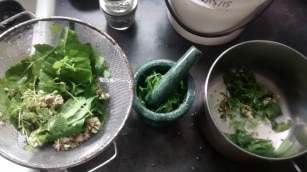
If you’re in a survival situation and don’t have coconut oil, you could make a liquid rub with olive oil or any other fat that is safe to spread onto the skin. You could conceivably even process animal fat for this purpose.
The thing I use this stuff for most is mosquito bites, which I get all over my body in the form of itchy red welts. Mosquitos are a scourge during southern summers, and aside from a momentary cooling sensation, nothing I’ve ever bought at the store seems to help the itch.
After rubbing on a generous amount of this wild plant-based miracle salve, on the other hand, I completely forget about the bites after about five minutes. The itch is erased.
I use it in any of the ways I’d use Gaye’s original healing miracle salve: cuts, scrapes, wounds, boils, rashes, you name it! After giving some of it as a gift, I even got feedback that it helped relieve itching associated with menopause. It’s also pet-safe!
Ingredients:
- 3-4 cups coconut oil
- Half a teaspoon of olive oil infused with vitamin E (optional, but adds nutrients and acts as a preservative)
- 5 tablespoons beeswax
- 1-2 cups slightly crushed medicinal leaves and flowers
Medicinal Plants:
Below is a quick listing of the plants that you can use, with some identifying characteristics and images. Look for these in your yard and around your property, and you’re likely to find many of them just beyond your door. They even grow in parking lots!
For details on the medicinal properties of each of these, take a look at this great resource. I’d expect a salve that used any combination of 2-4 of these plants to be effective, but at the risk of overkill, my version uses them all:
1. Common Plantain Leaves (Plantago major)
Common Plantain has nothing to do with the banana plantains you see in stores. It has tough ovoid leaves with distinctive veins and grows in a basal rosette. Tiny flowers form on a stalk.
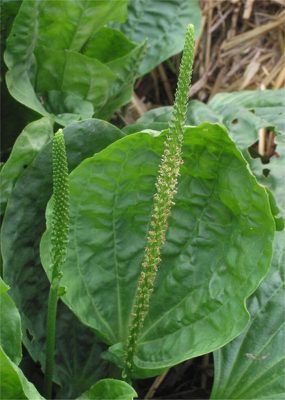
Once a mainstay in native Indian medicine, homeowners from California to Maine now work all spring and summer trying to vanquish this powerful healing plant from their yards.


It is very similar to the common broadleaf variety, except the leaves are lanceolate instead of ovoid.
2. Narrowleaf Plantain Leaves (Plantago lanceolata)
This cousin of the broadleaf plantain has tough, lance-shaped leaves that grow in a basal rosette near disturbed lots, roadsides, and lawns.
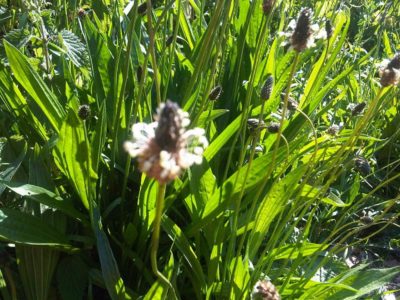

3. Ground Ivy Leaves (Glechoma hederacea)
Ground Ivy is a creeping plant with scalloped leaves and small blue flowers. All parts smell minty when crushed.

The stem is square, not round, and leaves are alternate, meaning the leaf pairs appear in a staggered pattern along the stem.

4. Wood Sorrel Leaves (Oxalis)
Usually mistaken as clovers, wood sorrel leaves have a shamrock-like appearance.
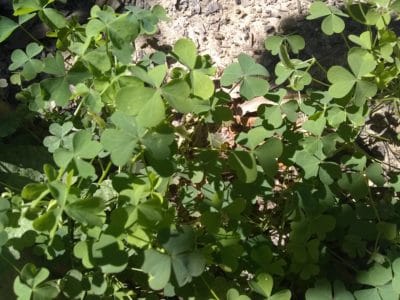
The flowers are small and can be either white, yellow, pink, or purple.

5. Red and White Clover Flowers (Trifolium pratense/Trifolium repens)
For most newbie foragers, this common weed is as easy to identify as a dandelion. The flowers have been prized for centuries for their medicinal qualities.


Step 1: Gather and Crush the Plants
I used about two cups’ worth of total plant material for a liter or so of salve, using approximately equal amounts of each plant with the exception of wood sorrel, which I only used a very small amount of.
You can make a smaller recipe and the amount of plant matter doesn’t have to be precise, just err on the side of too much to ensure your formula is potent enough. Once they are gathered, use a colander to rinse them thoroughly.
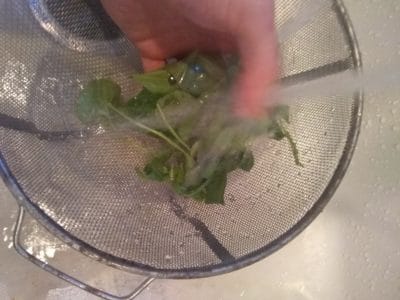
Then use a mortar and pestle or other technique to crush them slightly, just enough so that those membranes are broken and the leaves release a bit of juice.
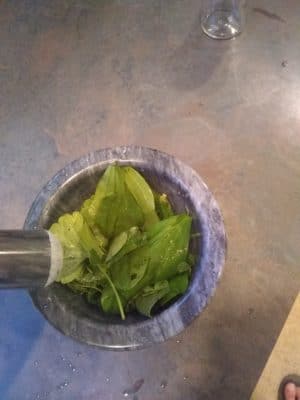
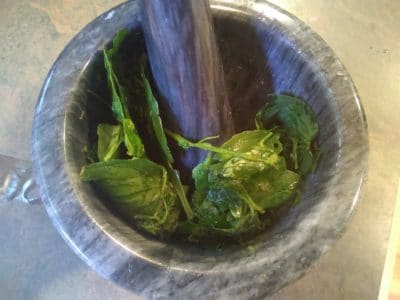
Then I put them into a pot with the coconut oil.
Step 2: Patiently Simmer
Melt the coconut oil at extremely low heat, and make sure you’ve used enough oil that the plant matter is submerged once it melts. Now all you do is simmer, simmer, simmer.
I left mine on for about three hours, but it might be better to leave it on even longer to ease out more of those active chemicals from the plants. The oil should turn a nice green color.

After a few hours or more of simmering, strain the liquid out. There may be some plant matter that finds its way through, which is fine. I didn’t have cheese cloth, but it would have helped to keep some of that extra plant material out of my final product. I like to really try to squeeze the plants to get out as much of the oil as I can.
Step 3: Cool Down
Now just let it cool for about 24 hours. It should keep fresh for a long time – I’d say up to a year or longer in the fridge.
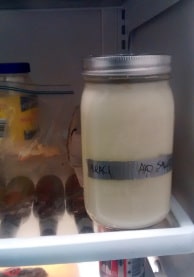
If you’re going to refrigerate yours, just rub your fingers on the salve until the warmth from the friction softens it enough to be applied.
Wild plant-based healing salve is cheaper, fun to make, and is even stronger and more effective (in my experience) than the myriad over-the-counter products it replaces. See what plants you find in your yard, and make a salve that renders store-bought first aid ointments obsolete!
Author Bio: Eric is a nature-loving writer, experience junkie, and former Boy Scout who never forgot that time-honored Scout Motto: Be prepared. Aside from camping and survival, he loves writing about travel, history, and anything he finds strange and unique!
If you enjoyed this article, consider following our Facebook page.
The Final Word
You have not heard the last of this. In addition to this DIY Miracle Healing Salve, I have made batches of Tea Tree Skin Ointment and Lemon Salve. These are themes of the basic formula that were put together to take advantage of the specific properties of oils used in their formulation. I am also experimenting with an infusions of dried oregano and olive oil.
As with all things at Backdoor Survival, I am testing first posting later. Stay tuned!
Enjoy your next adventure through common sense and thoughtful preparation!
Gaye
If you enjoyed this article, consider subscribing to email updates. When you do, you will receive a free, downloadable copy of my e-Book, The Emergency Food Buyer’s Guide.
You can also vote for Backdoor Survival daily at Top Prepper Websites!
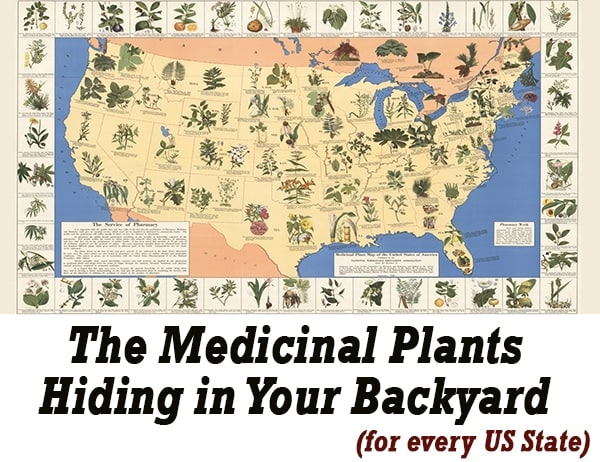
Bargain Bin: Here are some links to items used to create your custom-crafted Miracle Healing Salve.
White Plastic Jar with Dome Lid 2 Oz (12 Per Bag): I often chose to use these small ointment jars rather than Mason jars for my salve. I also have similar jars in the 1 ounce size.
Ball Jar Crystal Jelly Jars with Lids and Bands, Quilted, 4-Ounce, Set of 12: Sometimes I use plastic and sometimes I use mason jars. Honestly? It is a matter of personal preference.
Beeswax Organic Pastilles, Yellow, 100% Pure 16 Oz: I ordered the white pastilles but have since learned that the natural yellow pastilles are better. That said, the difference may not be discernable – just be sure that what you purchase is cosmetic grade.
Glass Droppers, Pack of 6: I bought a package of these and loved them. When I went to re-order, I accidentally ordered plastic instead glass droppers. Learn from my mistake. The price is the same go get the glass ones.
Spark Naturals Essential Oils: These is what you need for the Miracle Salve: Lavender essential oil, Rosemary essential oil, and Peppermint essential oil. Enjoy a 10% discount on your Spark Naturals order with code BACKDOORSURVIVAL at checkout.
NOW Foods Essential Oils : My salves were made using essential oils from Spark Naturals. My sniff test tells me they are stronger and more pure smelling. For healing purposes, I feel they are superior. On the other hand, NOW Foods has decent essential oils at a budget price: NOW Foods Rosemary Oil, NOW Foods Peppermint Oil and Now Foods Lavender Oil.
Coconut Oil: Coconut Oil from Tropical Traditions is my preferred coconut oil. I love it so much I purchased a 5 gallon tub. Really, I did! I find it very silky to work with and love the taste when used in cooking. Note that no refrigeration is required and although it solid at room temperature, it melts at 76 degrees. The Nutiva brand from Amazon or Costco works well too.

Kirkland Signature Extra Virgin Olive Oil, 2 Liters (Product of Italy): If you have a Costco close by, get it their. Otherwise, you can use this or any other quality extra virgin olive oil.
The Complete Book of Essential Oils and Aromatherapy: I first became interested in aromatherapy and essential oils in the early 90s which was before they really became mainstream. I read every book I could get my hands on and dabbled at creating synergy’s (a combination of two or more oils that create a chemical compound that is greater than the some of its individual components). My bible then, and even now, is this book.
~~~~~~~~~~~~~~~~~~~~~~~~~~~~~~
~~~~~~~~~~~~~~~~~~~~~~~~~~~~~~
Amazon has a feature called Shop Amazon – Most Wished For Items. This is an easy tool for finding products that people are ‘wishing” for and in this way you know what the top products are. All you need to do is select the category from the left hand side of the screen.
The Amazon Top Most Wished For and Best Selling Outdoor Items
Emergency Preparedness Items from Amazon.com
Shop Amazon Tactical – Great Selection of Optics, Knives, Cases, Equipment
Amazon Gift Cards
Help support Backdoor Survival. Purchases earn a small commission and for that I thank you!
~~~~~~~~~~~~~~~~~~~~~~~~~~~~~~



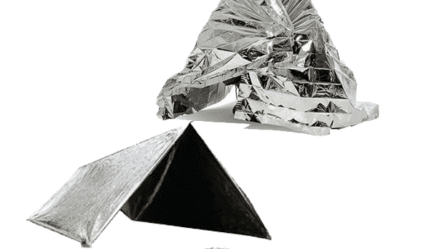






219 Responses to “DIY Miracle Healing Salve”
Gaye, I love melting and making my own lotions and wanted to try your recipe for healing salve. I went out today and bought some coconut oil. It is in the liquid form, now I’m not sure this will firm up with all the liquid. Does your recipe call for the solid coconut oil? Thank you for all you do, resources, free books, information on products. (Love my wonder mill). Yvonne
Yvonne – I don’t know what happened but a similar comment came through about an hour ago. See above for my response. Best . . . Gaye
I love making my own lotions, so I wanted to mix up a batch of your healing salve. I bought coconut oil that is in a liquid form, but now I don’t think that will firm up. When you listed the ingredients, are you using solid coconut oil? Thanks for what you do. Yvonne
Yes – I used the solid coconut oil. If it were me, I would save the liquid coconut oil (fractionated) for some other purpose.
Hi Gaye, quick question. Your recipe calls for 5 Tbl. Organic Beeswax Pastilles. Tbl as tablet or Tbl as tablespoon?
Thanks.
Keep doing what you do. It is a great deal of help.
That would be Tablespoon. Thank you for the kind words 🙂
I used a variation of this also for skin ointment for my animals. As far as you know, the application is safe for them?
Excellent thorough post by the way.
Bo
Bo – I have used diluted essential oils on Tucker the Dog with no problem. He does not like the smell of peppermint so I am very careful with that. When I say diluted, I mean with a carrier oil such as coconut oil or in my salve. I may be extra cautious but that is what I do.
I don’t have a cat but according to my research, cats assimilate oils differently than dogs and that you should use with extreme caution if at all.
John R – I had a 10 pound block of beeswax that I picked up a couple of years ago. To use this, I shave off the amount I need using a vegetable peeler.
You can get pastilles from http://www.mountainroseherbs.com out of Eugene Oregon. They are great and fast.
You can also usually find beeswax pellets in the candle making section of your local big box craft store (like Michaels or hobby lobby). I get mine from a store called pat Catan’s (formerly crafts2000). They also sell 1 pound blocks. Or try googling local beekeepers, I have gotten fresh local sourced beeswax that way as well.
How sold does this get? I have made healing salves and lotion bars before and the amount of beeswax in this recipe would indicate to me that it is not completely solid. Is this correct? The lotion bar I make is 1:1:1 ratio of coconut oil, coco butter and beeswax. It is pretty solid until you start to use it.
Leal – It is what I would call firm but not completely solid. It is similar in texture to jarred moisturizing cream – very silky.
Wonderful lady Gaye. I have to share some of my observations I have about you. When I first started reading your blog, you didn’t have a photo for me to see what you looked like. Then I was able to watch one of your videos on something that took flour. I was happy to see what you looked like, BUT, there is always a but, there you were mixing flour in a black dress. I chuckled, but before the video was over, you had changed into something else. You are learning as you teach. Now I see you mixing melting wax in a bowl, stirring it with what appears to be a knife from your fine silver.
Another observation. I was concerned over you living on an island in the ocean. I googled you yesterday to see where you lived. You are not in the ocean, you are in a bay. I no longer worry about you. Japan’s radiation is not going to get you through the water, maybe through the air, but it will get all of us then. Also as I googled you with the satellite imagery, I think I saw you in your backyard while taking your dog out for a walk. Go ahead and google yourself and see if that is not you in your green vest.
Concerning your salve. You just had to make me need more than I have in stock. What in the world is Organic Beeswax Pastilles? Also, you put tea tree oil in your husbands salve, but not yours. Is there a reason? I have plenty of tea tree oil.
Thanks Gaye for all you do and for putting up with me for all this time. I’ll let you know about the last thing you did for me in a while.
Well, if you must know, I was born with high heels on and a dress :). I really am a dress-up kind of person so yes, I do get overly dressed quite often. I typically will garden in white pants which makes good use of my “expired” bleach.
As far as the knife, that is just an ordinary knife from my kitchen drawer. Yep, the kitchen drawer has the fancy stuff. I am not a believer in squirreling away the good stuff for company.
We live at a harbor in the Salish Sea – salt water but inland from the Pacific. The green you saw is actually common area in front of our house. We have a tiny back yard – no grass.
Beeswax pastilles are pellets of beeswax. You could also grate your own but since I had to buy some anyway, I purchased the pastilles. Tea tree is a heavy-duty anti-fungal that I did not thing was necessary for an all-purpose salve. Plus, the smell is a bit obnoxious to my nose.
Okay now, John. You and the entire world now know a bit more about me. Lousy OPSEC.
I just started making these things and have a problem with the oils separating in the cooling process. They will stay blended if stirred in the little jars while cooling, but won’t if the mixture is just poured into the containers.
Any suggestions?
It may be the brands of oils (coconut, olive and Eos) that you are using. Also, is the coconut oil the solid type or the liquid? I have not had a problem so perhaps you can share more info and we can take it from there. My first batches were in Mason jars so I could see the oils while they were cooling and there was no separation.
Thanks! It will be most helpful to talk with others with more experience. I’ve been doing herbal medicines for many years, but only recently got into the coconut oil thing.
I used Nutiva coconut oil, a very fine pure bee’s wax pellet, and added a tiny bit of honey and vitamin E oil with flavorings to make lip balm. Looking back through what I produced, I think the problem may have been overheating the mixture at the last, since it looks as if the first few tubs I poured cooled mixed. I made so MUCH of it, however, that I’m not sure I want to try it again, at least not right away. What I can do is gently warm the little tubs of separated stuff that I mixed, and see if it will smooth out and not separate. That will tell me a lot. Right now the little tubs look like they are full of gray curds. I want to use these for Christmas gifts… so I had best get cracking. 🙂
I got started with this because I have bad keratosis all over, but especially in my scalp. I had tried using just coconut oil, but it made my hair look stringy and limp. Got to reading about it, and thought adding a bit of bee’s wax would help keep most of the oil on the scalp itself. Still have to make that, but I’ve kept using the coconut oil as a scalp conditioner and I seem to be shedding massive amounts of dead skin – hopefully thinning or eliminating the keratosis. I add tea tree oil to the coconut, but have to be very careful. I had some on my fingers and managed to touch my eye once… HOOOO BOY! Not a good idea.
I have actually re-mixed a batch because I wanted to add some additional oils and also I wanted to add additional wax. I actually am still testing this one which is my “everything but the kitchen sink” salve.
I have gas burners on my stove so what I do is bring the water to a slow simmer then turn the burner off. I get about a 90% melt. I then turn the burner on very low for the final melt.
I wonder if the problem is the honey? Why not take a small amount, re-melt it, add a little more wax and see what happens?
BTW, I found that using straight coconut oil on my skin and hair was very drying. Mixing it wiith olive oil made a huge difference.
honey can make a formulation separate.
Thanks for this tip. I will need to try this as I have been looking for a hand cream to help with the terrible eczema that I have had on my hands for the past year. It is so painful and so far nothing has really worked.
I wish I had taken a before and after of Shelly’s elbow so you could see the difference. I guess I should at least do the after picture. Let me know how it goes with your eczema.
I am going to try this. Been looking for an all around moisturizer, plus have a dog who constantly itches and licks causing hot spots and a visit to the vet. I know it’s just an estimate but any idea what the shelf life for something like this would be?
Thanks for sharing this!
I read that with the Vitamin E oil, the shelf life was a year. My first batches were 1/2 size and with all the testing, I went through them quickly so shelf life was not a problem. The other thing is that oils rarely go rancid in the cool, PNW climate.
Just to be safe, given the Texas heat and humidity, I would make half batches and definitely use the vitamin E. (We poked capsules with a pin and squeezed one capsule into each jar at the time we added the EOs.)
Be sure to check back and let me know how you like the salve.
I have a suggestion for your dog’s hot spot issue that I hope will help. Our dog had a hot spot about the size of a quarter. An ugly dark red circle on his hip and the hair fell out. I put coconut oil on it. It began to heal and the hair grew back. I like using something on him that I am sure won’t hurt him if he licks it off. I even give him a small amount to eat if he is having an upset stomach, it seems to help. If you do an online search for the benefits of coconut oil for dogs, you will find a lot of info.
Gaye,thanks so much for this recipe,I can’t wait to try it. Hubby and I are having a lot of dry hands since winter got here.
This is true! Coconut oil by itself is antibacterial and contains many other health benefits. I wrote an article which includes medical reviews on the health benefits of coconut oil not long ago, feel free to give it a read: //www.soulsalve.co/alchemists-corner/article2